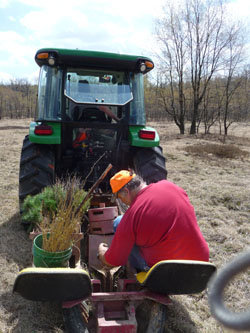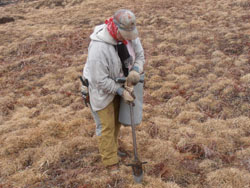News:
Press Release
September 5, 2013
SPECIES OF THE YOUNG FOREST FOCUS OF McKEAN COUNTY PROJECT

About 30,000 wildlife-beneficial trees and shrubs have been planted recently on the 17,500-acre Clermont Tract in southern McKean County to begin the restoration of the site as prime habitat for the American woodcock and other young-forest species
The planting is part of a long term effort to improve wildlife habitat and monitor wildlife populations on this site, which is managed by Forest Investment Associates.
The Clermont Tract was logged during the initial period of cutting across northern Pennsylvania in the mid-1800s and again in the first third of the 20th century. Slash fires were common after logging and deer numbers increased dramatically after the second cutting.
The drier sites came back in a black cherry dominated forest that produces some of the finest cherry lumber in the world, however, the wetter meadow sites never fully regenerated.
Aspen, willow and alders did come in following the cutting and beaver abounded along the stream bottoms creating and eventually abandoning impoundments. These areas normally would cycle back into shrub and tree habitat, which in turn would provide good habitat for woodcock and other brush loving species.
However, high deer numbers in the 1960's to 1990's prevented the natural regeneration of alders, willows and aspens that normally would grow in the drained areas of former beaver impoundments. These wet brushy habitats are favored by woodcock for feeding and nesting. Over time the lack of food reduced the beaver population in these areas to the point where beaver were no longer a major influence on the habitat cycle. The species that use young forest and shrub habitat, including the woodcock, snowshoe hare and ruffed grouse declined dramatically in these areas.
Despite the degraded habitat conditions across the tract, evening surveys in mid-April by volunteers from Woodcock Limited (WL) and the Ruffed Grouse Society (RGS) and staff from the Pennsylvania Game Commission (PGC) and Wildlife Management Institute (WMI) located a number of singing, male woodcocks. Such singing ground surveys are the standard U.S. Fish and Wildlife Service (USFWS) protocol for assessing woodcock numbers on a site.
Aiming to determine existing woodcock use across the Clermont Tract, the surveys are a first step in developing a management plan for the site that will demonstrate techniques to restore habitat for American woodcock and associated, young-forest species such as ruffed grouse, snowshoe hare and golden-winged warbler.
By comparing areas of the tract being used and areas not used on the same soil types, researchers will identify habitat components that need to be improved, as well as the impact of habitat restoration efforts, such as the recent planting of winterberry holly, northern arrow wood, silky dogwood, red osier dogwood, Washington hawthorn, trembling aspen, big-toothed aspen, high-bush cranberry, willow, white pine, red pine and white spruce.

Plantings were done by staff from Habitat Forever, USFWS, PGC, RGS and WL, using shrub and tree species selected to provide a variety of seeds and fruits, some that last well into the winter. They all will provide cover for young forest species for many years. Mary Hosmer of Ridgeway has been one of our most enthusiastic volunteers and has spent many days planting and surveying for woodcock. She said that she is excited about this project because she can see landscape scale changes taking place. Mary is active in with several of our cooperating organizations, including Woodcock Limited and the Ruffed Grouse Society.
Researchers believe the sod layer that has developed on the site is inhibiting the establishment of woody vegetation and may need to be broken up by scalping strips with a bulldozer to expose mineral soil to promote recolonization by aspen, alder, dogwood, viburnum, and other native shrubs. Direct seeding of those species is intended to augment natural regeneration.
While planting on the wet meadow sites will produce good habitat, the commercial management of the forest is the primary factor that will regenerate habitat for the shrub-loving species. The regeneration of the forest following the cutting of the last century produced the good old days for ruffed grouse, snowshoe hare, and later deer. As the forest matured, habitat for all of those species declined and the population of all of those species fell. Other species ranging from bobcat and weasels to warblers declined as well.
That forest is now mature and the harvest cycle is starting over again. This spells good news for all of brush-loving species in the northern tier of Pennsylvania.
Funding for the Habitat Forever staff was provided by a grant from the Wildlife For Everyone Endowment Foundation, using gifts to the foundation from donors from McKean County area.
Additional funding was provided by WMI and USFWS. The 30,000 seedlings were produced at the PGC's Howard Nursery and were made available for the project because FIA is a cooperator in the commission's Forest Game Program, which opens the site to hunting.
The Clermont Tract also is enrolled in the Private Landowner Opportunities for Woodcock (PLOW) program of Woodcock Limited of Pennsylvania.
[ Return to News ]
